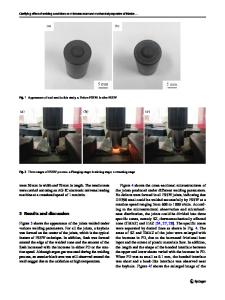Microstructure and Mechanical Properties of Low-Carbon Q235 Steel Welded Using Friction Stir Welding
- PDF / 9,910,519 Bytes
- 15 Pages / 595.276 x 790.866 pts Page_size
- 54 Downloads / 391 Views
Microstructure and Mechanical Properties of Low‑Carbon Q235 Steel Welded Using Friction Stir Welding Hongduo Wang1,3 · Kuaishe Wang1,2 · Wen Wang1,2 · Yongxin Lu3 · Pai Peng1,2 · Peng Han1,2 · Ke Qiao1,2 · Zhihao Liu1,2 · Lei Wang3 Received: 19 April 2020 / Revised: 14 June 2020 / Accepted: 18 June 2020 © The Chinese Society for Metals (CSM) and Springer-Verlag GmbH Germany, part of Springer Nature 2020
Abstract This study focuses on the microstructure and mechanical properties of the joints of Q235 mild steel, which was formed by the friction stir welding (FSW). The results indicated that, after the FSW, the heat-affected zone (HAZ) of the retreating side (HAZRS) and the HAZ of the advancing side ( HAZAS) recovered under the influence of the heating cycle. The transformation of the phases in the thermo-mechanically affected zone (TMAZ) of the retreating side (TMAZRS), the stir zone (SZ) and the TMAZ of the advancing side ( TMAZAS) generated the pearlite and acicular ferrite. The continuous dynamic recrystallization occurred in all the three zones, whereas the grains were refined. The SZ mainly consisted of D1, D2 and F shear textures, while the T MAZAS was made up of only the F shear texture. The fine-grained structure, pearlite and the acicular ferrite improved the hardness and tensile strength of the joint. Its ultimate tensile strength was 479 MPa, which was 1.3% higher than that of the base metal. However, the uniform elongation was 16%, which showed a decrease of 33%. The fracture was a ductile fracture with the appearance of dimples. Besides, the joints of the FSW showed an excellent bending performance. Keywords Low-carbon steel · Friction stir welding · Recrystallization · Phase transformation · Mechanical properties
1 Introduction The mild steel has been widely used in petroleum, chemical, natural gas, automobile and ship-building industries due to its low cost and high processing capability [1]. Generally, the mild steels are welded using the traditional fusion welding techniques, such as manual arc welding [2], molten electrode gas shielded arc welding [3] and the submerged arc welding [4]. However, these traditional fusion welding techniques are prone to cause problems, such as the solidified Available online at http://link.springer.com/journal/40195. * Wen Wang [email protected] Kuaishe Wang [email protected] 1
School of Metallurgical Engineering, Xi’an University of Architecture and Technology, Xi’an 710055, China
2
National and Local Joint Engineering Research Center for Functional Materials Processing, Xi’an 710055, China
3
School of Materials Science and Engineering, Xi’an Shiyou University, Xi’an 710065, China
cracks, porosity, the segregation of alloying elements and the grain coarsening during the process of welding, which lead to lower performance of the welded joints [5, 6]. The solid-state joining technology can solve the inherent defects in the solidified structure, which are caused by the traditional fusion welding technology [7, 8]. Due to this reason, it
Data Loading...











